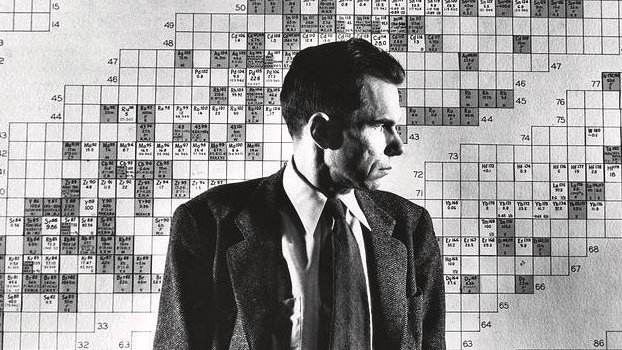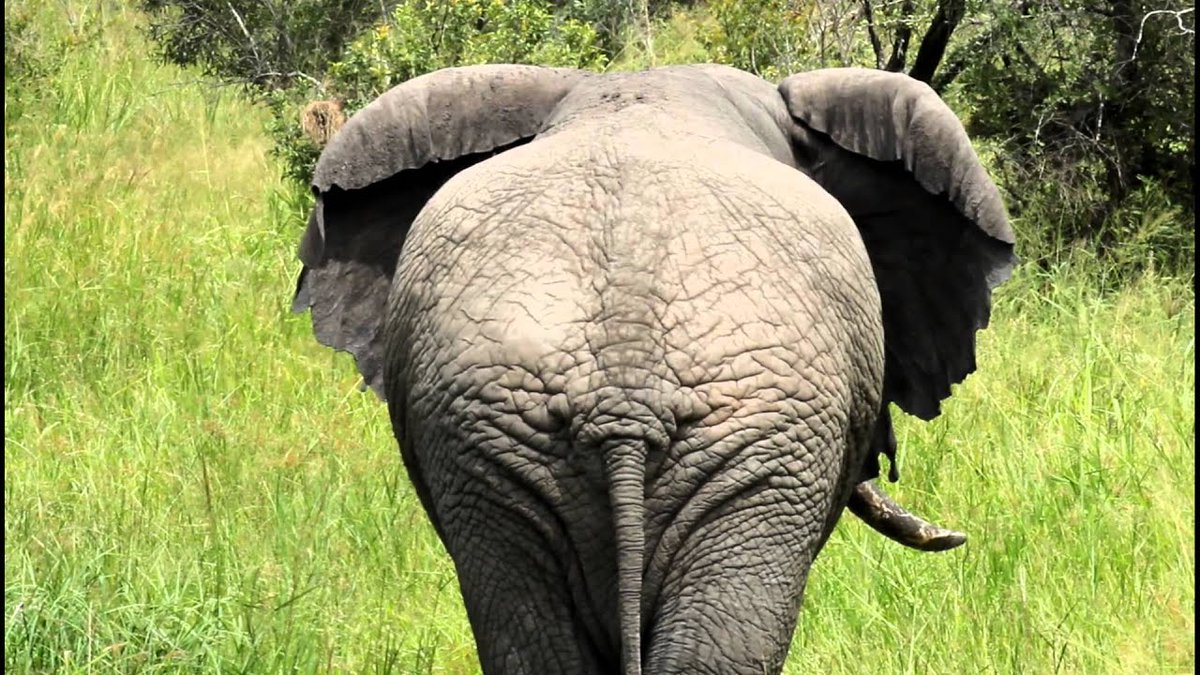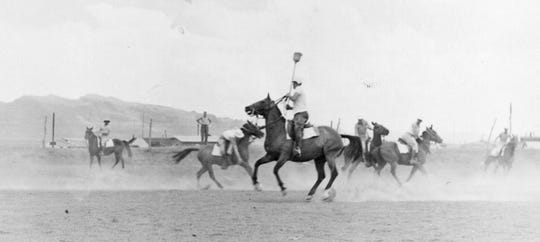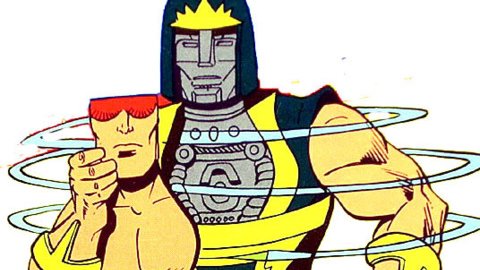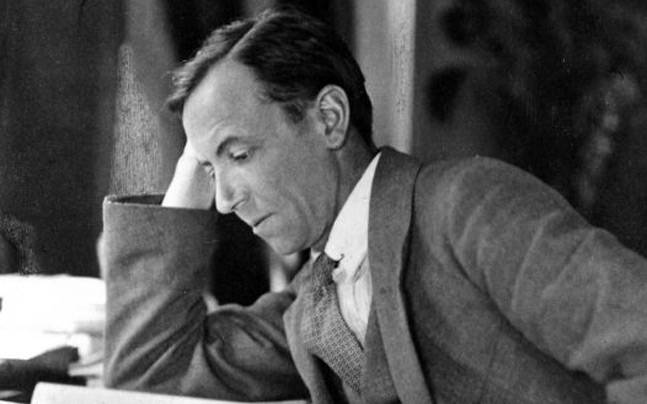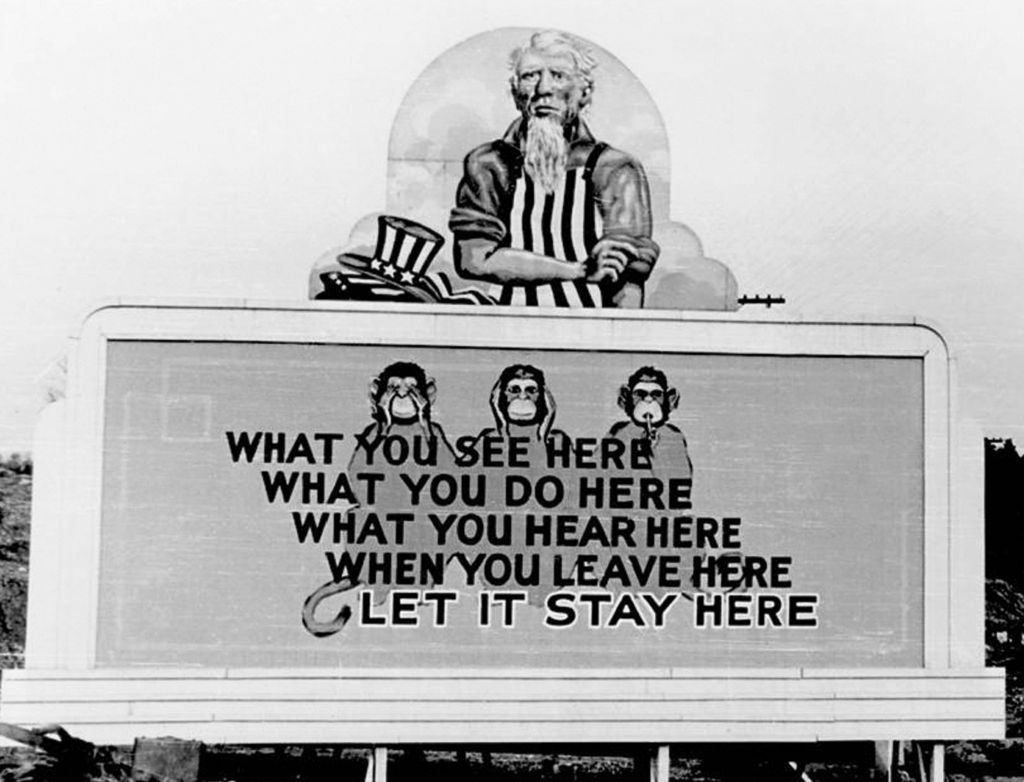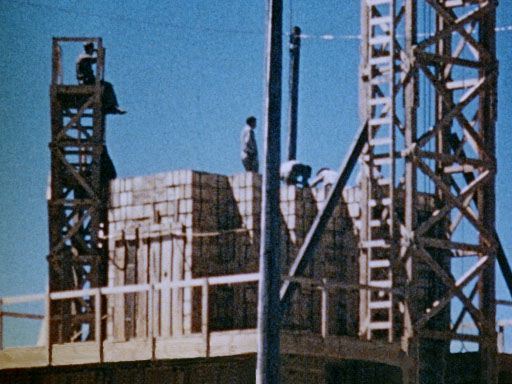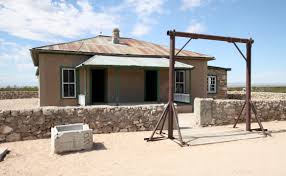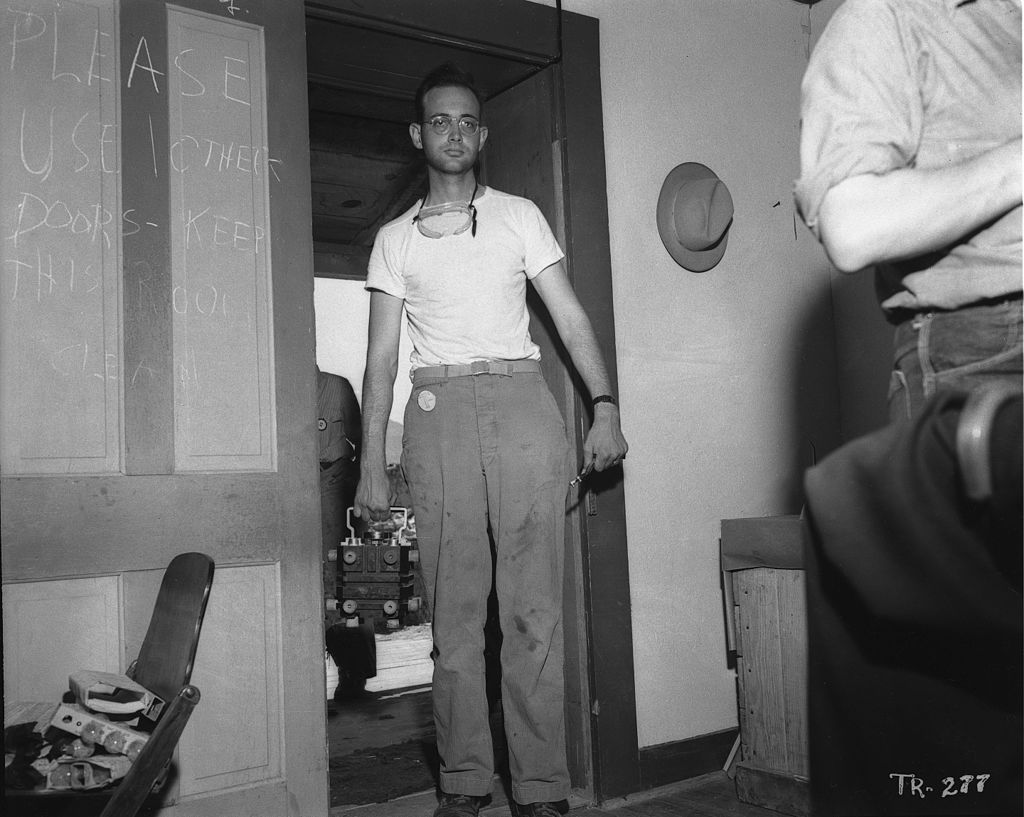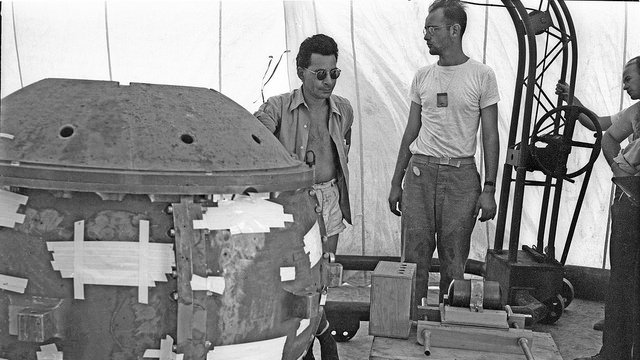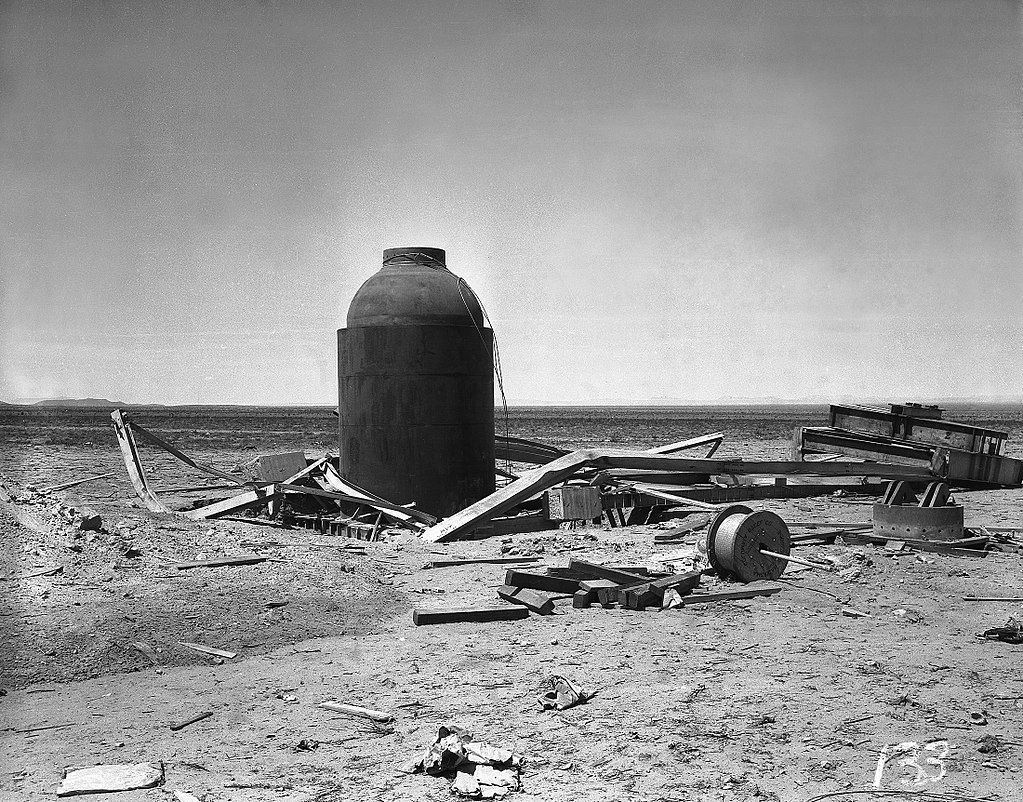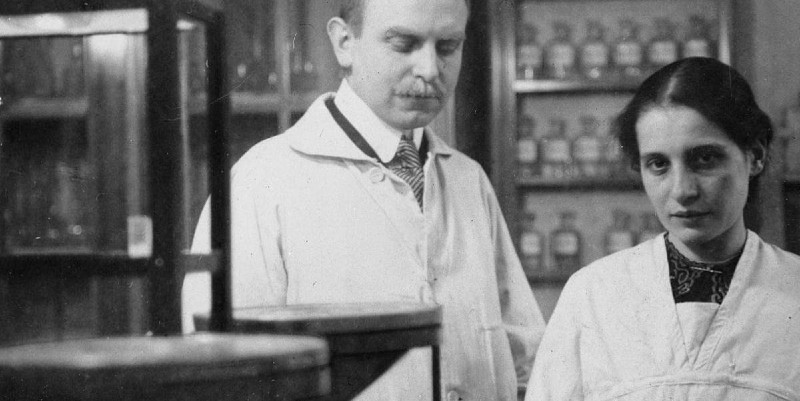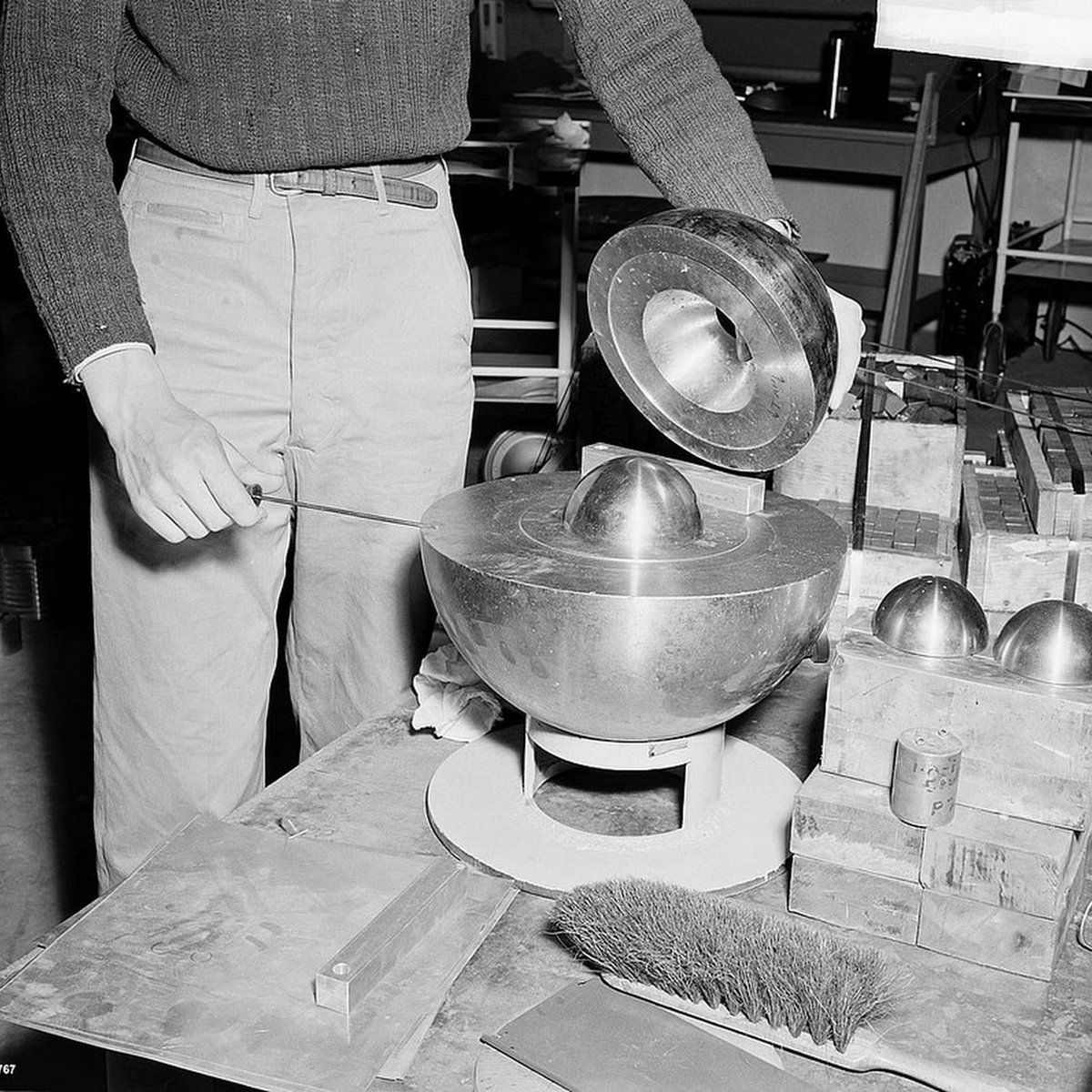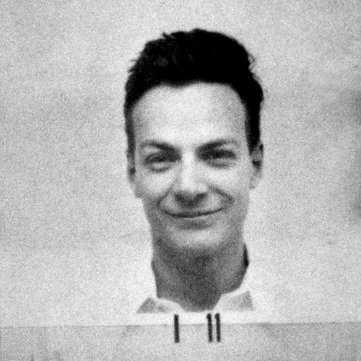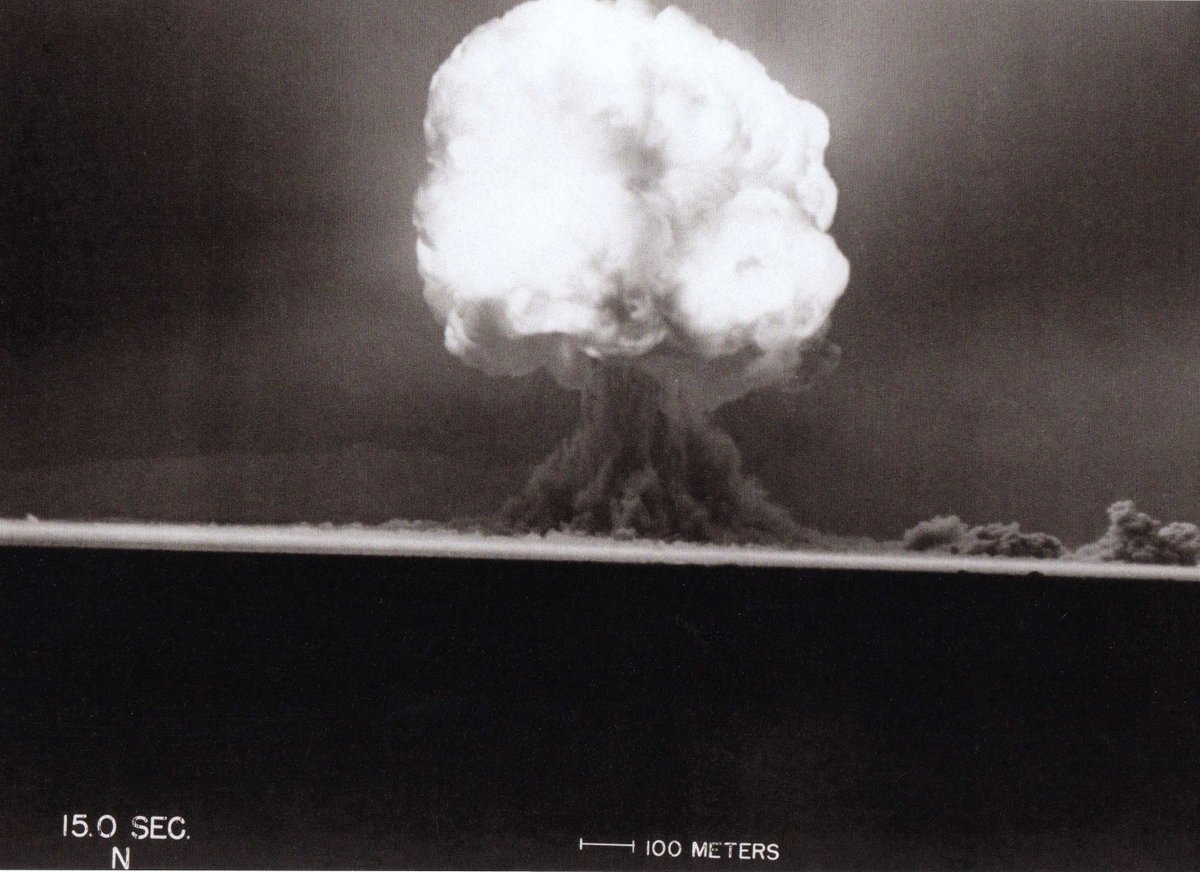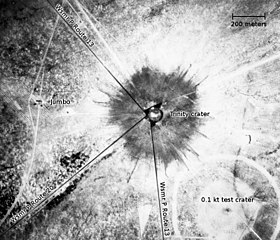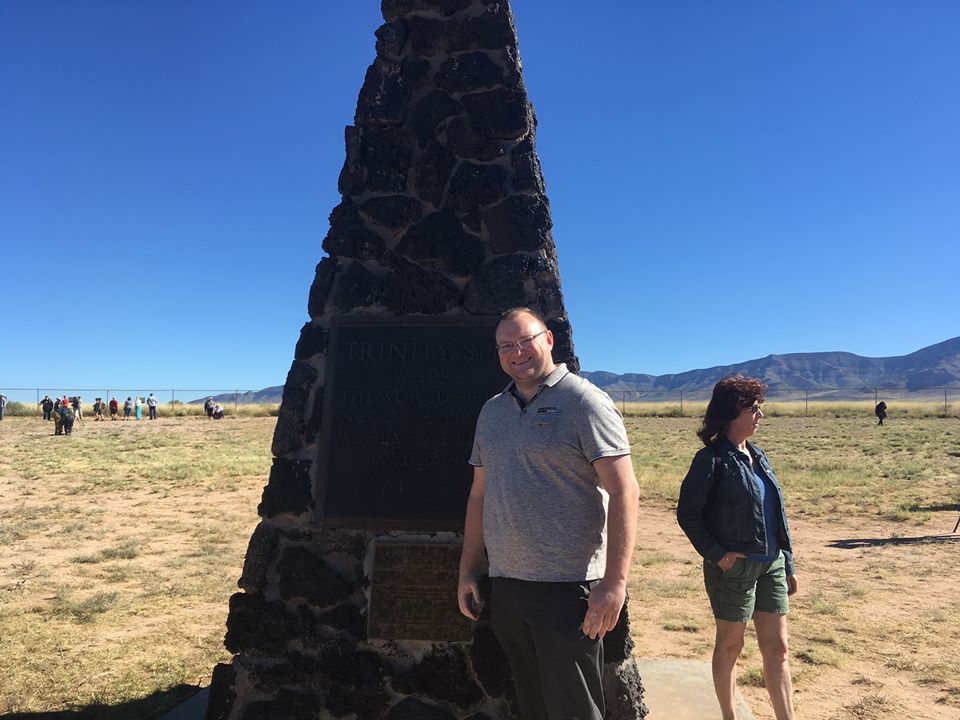4.00AM. 16 July, US Mountain Time. 75 years ago today, the world was changed forever.
Come back in time with me as I live-tweet the detonation of Gadget, the world’s first nuclear weapon.
We are now in 1945. A stormy, wet New Mexico. The world is about to enter the atomic age.
Come back in time with me as I live-tweet the detonation of Gadget, the world’s first nuclear weapon.
We are now in 1945. A stormy, wet New Mexico. The world is about to enter the atomic age.
We are now at a potential scheduled time for the test but thunderstorms are raging. Jack Hubbard, meteorologist, has assured Leslie Groves, the man in charge, that the weather will clear.
Groves tells Hubbard if he’s wrong: “I will hang you.”
Groves tells Hubbard if he’s wrong: “I will hang you.”
Groves, moustached, paunchy and in his late 40s, is the head of the Manhattan Project. He is a US Army engineer who took charge of the atomic bomb project in September 1942.
It has since become the largest science project in human history.
It has since become the largest science project in human history.
Groves oversaw construction of the Pentagon and has a reputation of being an arrogant dick who works with ruthless efficiency.
Kenneth Nichols: “General Groves is the biggest S.O.B. I have ever worked for. He is most demanding. He is most critical.” He is the perfect leader.
Kenneth Nichols: “General Groves is the biggest S.O.B. I have ever worked for. He is most demanding. He is most critical.” He is the perfect leader.
Side fact about the Pentagon: it has *a lot* of bathrooms. The reason is horrible, though. It was built at a time when there was segregation. https://www.snopes.com/fact-check/pentagon-bathrooms/">https://www.snopes.com/fact-chec...
Leading the scientific side of the project is Robert Oppenheimer.
A left-field choice, a man with no Nobel prize, Groves’ pick is a blinder. Unlike other atomic projects (more later) the Manhattan Project has gone very well.
A left-field choice, a man with no Nobel prize, Groves’ pick is a blinder. Unlike other atomic projects (more later) the Manhattan Project has gone very well.
Oppie is from a family that was WEALTHY AF. They lived on the upper west side of Manhattan and owned 3 Van Goghs.
He then swanned around Europe before ending up a professor at Berkeley. He is erudite and classy, often thinking of poetry and the Gods.
He& #39;s brilliant of course.
He then swanned around Europe before ending up a professor at Berkeley. He is erudite and classy, often thinking of poetry and the Gods.
He& #39;s brilliant of course.
Speaking of Nobels, btw, the desert is littered with them. Enrico Fermi, James Chadwick and Ernest Lawrence are all present. Future Nobel laureates are there too: Richard Feynman, Norman Ramsey,Emilio Segrè, Luis Alvarez...
A lot of science bling here.
A lot of science bling here.
Other Nobellists or future nobellists have been working in Chicago: Arthur Compton and future winner Glenn Seaborg. And Seaborg is the reason we& #39;re all here.
He created a little something called plutonium.
He created a little something called plutonium.
(Side note: I LOVE that photo of Seaborg. Here& #39;s some modern badass scientists, @nuclearkatie and @ProfArno, doing similar poses. Icon.)
Back to 1945.
The test is taking place at Alamogordo in the White Sands Military Reservation. It is in the middle of a desert known as the jornada del muerto – the ‘journey of the dead man’. To the NW is Socorro. To the SW is the hilariously named Elephant Butte.
The test is taking place at Alamogordo in the White Sands Military Reservation. It is in the middle of a desert known as the jornada del muerto – the ‘journey of the dead man’. To the NW is Socorro. To the SW is the hilariously named Elephant Butte.
I’ve been to this desert. It’s hot, and dry and sort of scrubby, lots of little bushes among the endless flat where only ants and tumbleweeds roam.
That& #39;s the reason for the & #39;dead man& #39; epithet. There& #39;s no water for miles until you hit the Rio Grande.
That& #39;s the reason for the & #39;dead man& #39; epithet. There& #39;s no water for miles until you hit the Rio Grande.
Many of the scientists have been living here, in the desert, on a military test range, in primitive isolation for weeks. It hasn’t been fun.
Groves has ordered no ‘luxuries’ and the water supply is so alkaline it can’t be drunk. Eugh.
Groves has ordered no ‘luxuries’ and the water supply is so alkaline it can’t be drunk. Eugh.
The only recreation is to play polo with the horses. Worse, due to the proximity to an air force training site, the scientists have been accidentally bombed twice.
Whoopsies.
Whoopsies.
The test, like everything else, has a codename: Trinity. Its origin is unknown, but Oppenheimer later wrote to Groves it was his suggestion, a reference to the poet John Donne: “Batter my heart, three person& #39;d God.”
Here& #39;s Donne& #39;s portrait. Sort of a Tudor emo-hipster.
Here& #39;s Donne& #39;s portrait. Sort of a Tudor emo-hipster.
In total, there are 425 personnel present at the site. It was chosen months ago. The man in charge of the test, Kenneth Bainbridge, first saw it in January through a snow storm. As he entered the test site “snow became rain. Slithering through soapy adobe road we passed through.”
4.15AM. T -75 mins. Bainbridge has had a rough time. After being bombed the second time, he contacted Oppenheimer and asked if he could return fire. Just talking to the main scientists in Los Alamos is hard, as phone communication has to go via a telephone line in Denver.
There have been several farcical moments during the test.
On 12 July, Kenneth Greisen was transporting top-secret equipment when he was pulled over outside Albuquerque for speeding. Fortunately the police officer didn’t check his trunk.
On 12 July, Kenneth Greisen was transporting top-secret equipment when he was pulled over outside Albuquerque for speeding. Fortunately the police officer didn’t check his trunk.
Secrecy has been tight. In April, DC Comics was raided after a Superman strip got a little too close to the truth by mentioning ‘cyclotrons’, a type of particle accelerator. It wasn’t a secret: Ernest Lawrence had won the Nobel prize for the cyclotron in 1939.
(The DC story is often dismissed as untrue by other accounts, but I like it. I also like how DC later naked a character ‘Cyclotron’ and his grandson, ‘Atom Smasher’.)
It hasn’t been a total success with the secrecy. Klaus Fuchs is a Soviet spy who has been leaking details of the atom bomb to the USSR (who are supposedly allies). He is present at Trinity.
The person who’s had the roughest night is Don Hornig. Both he and his wife Lilli have worked on the bomb. He has volunteered to babysit the device. “... as the youngest guy present, I was selected. I don’t know if I was most expendable or best able to climb a 100-foot tower!”
As not much is happening in 1945 (they& #39;re all waiting anxiously), a quick cheeky plug: if you want to know more about how we discovered plutonium, my book Superheavy is available on Amazon. It& #39;s all about that stuff - and beyond.
https://www.amazon.com/Superheavy-Making-Breaking-Periodic-Table/dp/1472953894/ref=pd_rhf_gw_p_img_3?_encoding=UTF8&psc=1&refRID=F5QF4T7SMTG7A4APGY7X">https://www.amazon.com/Superheav...
https://www.amazon.com/Superheavy-Making-Breaking-Periodic-Table/dp/1472953894/ref=pd_rhf_gw_p_img_3?_encoding=UTF8&psc=1&refRID=F5QF4T7SMTG7A4APGY7X">https://www.amazon.com/Superheav...
4.30AM. ONE HOUR TO GO.
Most of the observers are in position. The nearest are 10,000 yards away, in the North, West and South shelters. Most are at base camp, 10 miles away. Groves has taken a VIP party to Compania Hill, 20 miles away. James Chadwick is there as British rep.
Most of the observers are in position. The nearest are 10,000 yards away, in the North, West and South shelters. Most are at base camp, 10 miles away. Groves has taken a VIP party to Compania Hill, 20 miles away. James Chadwick is there as British rep.
The rain has stopped. The scientists, many of whom have not slept, feel tense.
None more so than Bainbridge: “My personal nightmare was knowing that if the bomb didn& #39;t go off or hangfired, I ... would have to go to the tower first and seek to find out what had gone wrong.”
None more so than Bainbridge: “My personal nightmare was knowing that if the bomb didn& #39;t go off or hangfired, I ... would have to go to the tower first and seek to find out what had gone wrong.”
It’s not an idle thought. On 14 July a dress rehearsal with no nuclear material took place… and the bomb didn’t go off!
It was later shown to be due to overworked practice kit.
Squeaky bum time.
It was later shown to be due to overworked practice kit.
Squeaky bum time.
Why is Trinity happening? It’s a good question. There is already another atomic bomb in play, on the USS Indianapolis, currently in San Francisco.
It is called Little Boy, and will be used on Hiroshima to awful, horrifying effect in less than a month.
It is called Little Boy, and will be used on Hiroshima to awful, horrifying effect in less than a month.
The answer as to why a test is needed is simple enough: nobody’s sure what will happen. Little Boy, a uranium bomb, is considered certain to be successful. Gadget, a ‘Fat Man’ bomb, is more risky. It’s made from plutonium.
Here is a fat man (me) next to a Fat Man.
Here is a fat man (me) next to a Fat Man.
Plutonium is a top secret discovery, usually referred to as ‘copper’ or ‘49’. It was found at UC Berkeley by a team led by Seaborg in 1941.
Fun fact: it was isolated in a stinky attic in the middle of the night during a thunder storm. The attic is why its symbol is Pu (pee-eew!)
Fun fact: it was isolated in a stinky attic in the middle of the night during a thunder storm. The attic is why its symbol is Pu (pee-eew!)
The codenames were a source of confusion. When the team needed *actual* copper, they had to call it ‘honest to God copper’! ‘49’ is the reverse of the element’s atomic number: 94.
Plutonium doesn’t exist on Earth – it is made by a process called neutron capture.
Plutonium doesn’t exist on Earth – it is made by a process called neutron capture.
(OK, plutonium does exist in TINY amounts on Earth.)
Anyway, it was such a longshot that on 6 December 1941, Harvard President James Conant was dismissive of it for a bomb. "Glenn Seaborg is a competent chemist, but he isn& #39;t THAT good."
24hrs later Japan attacked Pearl Harbor.
Anyway, it was such a longshot that on 6 December 1941, Harvard President James Conant was dismissive of it for a bomb. "Glenn Seaborg is a competent chemist, but he isn& #39;t THAT good."
24hrs later Japan attacked Pearl Harbor.
Seaborg’s researchers moved to Chicago to continue work. There they were helped by Fermi, who created the world’s first nuclear reactor: the ‘Chicago Pile’, under the bleachers of the university’s Stagg Field sports stadium.
Because that& #39;s where you want a nuclear reactor?
Because that& #39;s where you want a nuclear reactor?
This was a prelude to larger projects to make plutonium and enrich uranium (as specific isotopes are required). The largest were at Oak Ridge in Tennessee and the Hanford Site in Washington. The bomb was made at Los Alamos, New Mexico.
Oak Ridge has become a ‘secret city’, with 70,000 people working there. It has the world’s largest building and the first permanent nuclear reactor. The assistant cafeteria manager is Harland Sanders, who will found KFC.
Oak Ridge was infamous for two things: its muddy roads (it was built pretty much from scratch) and everyone visiting getting the runs.
A LOT of women worked here and their role is often overlooked. Here& #39;s a book on & #39;em: https://www.amazon.com/Girls-Atomic-City-Untold-Helped/dp/1451617534
Anyway,">https://www.amazon.com/Girls-Ato... back to the bomb…
A LOT of women worked here and their role is often overlooked. Here& #39;s a book on & #39;em: https://www.amazon.com/Girls-Atomic-City-Untold-Helped/dp/1451617534
Anyway,">https://www.amazon.com/Girls-Ato... back to the bomb…
While uranium bombs can be detonated with a simple trigger, the plutonium core needs to be imploded (hence the fat shape of the bomb). Squishy squishy boom boom.
A betting pool has opened. Edward Teller (pictured), who is passing out sunscreen, thinks the blast will be 45 kilotons. Norman Ramsey thinks it won’t go off. Oppenheimer thinks 0.3 kilotons. Isidor Isaac Rabi, last to pick, goes for 18 kilotons.
Fermi, mischievous as ever, has his own pool. Last night he took bets on whether the bomb will ignite the atmosphere and roast the entire Earth to a crisp. Bainbridge is furious – the guards don’t realise Fermi is joking and some are terrified.
HILARIOUS, FERMI.
HILARIOUS, FERMI.
How do they know the blast strength? A calibration test had occurred on 7 May. Just over 100 tons of explosives were detonated from a giant cube on a 20 foot tower.
Unlike the test run for the bomb, that one DID go off.
Unlike the test run for the bomb, that one DID go off.
4.45AM.
News from Hubbard’s meteorology team. The weather is favourable.
THE TRINITY TEST IS GO.
Gadget will be detonated at 5.30AM.
Now comes the time to arm the bomb.
News from Hubbard’s meteorology team. The weather is favourable.
THE TRINITY TEST IS GO.
Gadget will be detonated at 5.30AM.
Now comes the time to arm the bomb.
The bomb itself is already hoisted atop a 30 metre shot tower. Bainbridge and the others at the tower are finally able to do something. They have been rained on all night with nothing to do but occasionally flip the lights on and off out of boredom.
4.46AM. Bainbridge picks up the phone to John Williams, at the South bunker with Oppenheimer. “Prepare to fire at five-thirty.”
He then drives Joe McKibben out to West 900. McKibben is the man who will actually activate the bomb.
He then drives Joe McKibben out to West 900. McKibben is the man who will actually activate the bomb.
There are two other large objects inside the immediate blast zone. The first is the MacDonald ranch house – a squat adobe that was surrendered to the military by the family.
The bomb was assembled here in the master bedroom by on 13 July.
(The current structure is a replica.)
The bomb was assembled here in the master bedroom by on 13 July.
(The current structure is a replica.)
The arrival of the plutonium core was bizarre. Herbert Lehr walked through the wrong door, but before he could hand it over, there was an objection. Robert Bacher pointed out the bomb was technically property of the University of California – and asked for a receipt!
Here, the highest ranking general in the room, Thomas Farrell (Groves& #39; exec officer), decided to have fun: ‘If I was going to sign for it, shouldn’t I take it and handle it?’
So he took the bomb in his hands!
So he took the bomb in his hands!
Farrell: So I took this heavy ball in my hand and felt it glowing warm. I got a sense of its hidden power [ … ] for the first time I began to believe some of the fantastic tales the scientists had told about this “ nuclear power ”.’
Louis Slotin, the man who assembled the bomb in the bedroom (dude who looks like Jeff Goldblum), is Canadian. He has less than a year to live. On 30 May 1946 he will be messing around with a nuclear core using only a screwdriver for safety. The screwdriver will slip.
The other large object in the desert is Jumbo. A 200-ton metal cylinder, 10 foot wide and 25 foot long. It cost $12 million to make. Why’s it out here? Initially the plan was to blow up the bomb inside it, in case the bomb only half went off and spewed plutonium everywhere.
Jumbo won’t be used. Instead it’s suspended from a nearby tower. Groves is hoping it’ll be destroyed in the blast so he won’t have to explain why he wasted millions on a lump of metal.
4.51AM. 39 MINUTES TO GO. At W900, McKibben begins flipping the timing and sequencing switches. Bainbridge checks off things to make sure they are done correctly. He also phones Williams to tell him EXACTLY what they have done. If Bainbridge dies it’s important someone knows why.
Bainbridge heads back to the tower. He has one last job to do. He has a secret arming switch; until he flips it manually, the bomb cannot go off.
He does so, then turns on the ground lights used to line up B-29 flights.
THE BOMB IS READY TO DETONATE.
He does so, then turns on the ground lights used to line up B-29 flights.
THE BOMB IS READY TO DETONATE.
5AM. 30 MINUTES TO GO.
Bainbridge arrives at the south shelter, 10,000 yards away. There is one task left: weather reports. He begins to broadcast wind velocity to colleagues in the north and west bunker.
Here& #39;s a good map of the test layout from the US Dept. of Energy OSTI.
Bainbridge arrives at the south shelter, 10,000 yards away. There is one task left: weather reports. He begins to broadcast wind velocity to colleagues in the north and west bunker.
Here& #39;s a good map of the test layout from the US Dept. of Energy OSTI.
We have a little time, so what’s going on elsewhere? The war in Europe is over. The Nazi bomb project never really got going (too much bureaucracy) and its leaders have been rounded up.
They’re mostly now in Farm Hall, a manor just outside Godmanchester, UK.
They’re mostly now in Farm Hall, a manor just outside Godmanchester, UK.
Even with spies like Fuchs, the Russian bomb project is well behind. It didn’t kick off until a then-unknown lieutenant called Georgy Flerov sent a very snarky letter to Stalin telling him he was a dumbass for not looking into it. Flerov, miraculously, was not shot.
The Japanese projects (there are two) are in tatters. The lead project, Ni-Go, led by Yoshio Nishina, was basically a con to get free lab equipment from the military. But its base, at RIKEN, has been bombed by the Allies. The project is no more.
At the Trinity base camp, the sun is beginning to rise. Everyone is nervous. Will it work? Won& #39;t it? This is the culmination of a project that has involved more than 100,000 people across the US.
That& #39;s right: the Manhattan Project employed more people than an actual army.
That& #39;s right: the Manhattan Project employed more people than an actual army.
5.09AM. T-MINUS 20.
Bainbridge unlocks the master switch at S10,000 to activate the bomb.
McKibben starts the timer.
THE COUNTDOWN BEGINS, read by Samuel Allison. Allison is a physicist and was part of the team that built the world’s first nuclear reactor under Fermi.
Bainbridge unlocks the master switch at S10,000 to activate the bomb.
McKibben starts the timer.
THE COUNTDOWN BEGINS, read by Samuel Allison. Allison is a physicist and was part of the team that built the world’s first nuclear reactor under Fermi.
Fermi’s a Nobel winner. Let& #39;s talk about him.
In 1934 he claimed to have made the first elements past uranium by neutron capture – the idea that shooting neutrons into the heart of an atom, its nucleus, will cause it to radioactively beta decay and turn a neutron into a proton.
In 1934 he claimed to have made the first elements past uranium by neutron capture – the idea that shooting neutrons into the heart of an atom, its nucleus, will cause it to radioactively beta decay and turn a neutron into a proton.
(Elements are decided by their number of protons. So uranium has 92 – plutonium has 94, so requires two beta decays to happen.)
Fermi was in Fascist Italy at the time, and used his Nobel as an excuse to escape Europe with his Jewish wife under Mussolini& #39;s nose.
Fermi was in Fascist Italy at the time, and used his Nobel as an excuse to escape Europe with his Jewish wife under Mussolini& #39;s nose.
Thing is? A month later he found out he was wrong. Otto Hahn and Lise Meitner, who& #39;d fled Germany as she was Jewish,along with Otto Frisch (who is working on the Manhattan Project) discovered what actually happened: the neutron made the atom overload and ‘splode.
A splodin’ atom releases A LOT of energy (E=mc2, Einstein fans). And if you can get a chain reaction of atoms splodin’ – which requires certain types, or isotopes, of uranium or plutonium – you start getting a nuclear bomb.
You just need a lot of atoms to go boom.
You just need a lot of atoms to go boom.
The Fat Man Bomb itself weighs about 10,000g (4,700kg). But the important bit is the ‘pit’, about the size of softball. It weighs 13.6 pounds. It is made of two half-spheres of solid gallium–plutonium alloy. Inside is a beryllium-polonium neutron source used to kick-start it.
Modern nuclear weapons are even more powerful. They use heavy versions of hydrogen, deuterium and tritium, along with all kinds of fancy charges to get a more complete & #39;fission& #39; (more atoms blowing up).
This is what& #39;s called a thermonuclear weapon, or & #39;hydrogen bomb& #39;.
This is what& #39;s called a thermonuclear weapon, or & #39;hydrogen bomb& #39;.
5.20AM. T-MINUS 10 MINUTES.
Tension mounts in the desert. It& #39;s hard to breathe.
Everyone gets ready. They have been briefed not to look at the flash. Most will lie flat on the ground. Some will look through provided welding goggles.
Two idiots have decided to do neither.
Tension mounts in the desert. It& #39;s hard to breathe.
Everyone gets ready. They have been briefed not to look at the flash. Most will lie flat on the ground. Some will look through provided welding goggles.
Two idiots have decided to do neither.
Richard Feynman, a joker known for cracking safes in Los Alamos for a prank, has calculated a truck windscreen will protect his eyes from UV.
He is sat in the driver’s seat, waiting for the bomb like it’s a drive-in movie.
Ernest Lawrence has decided to do similar.
He is sat in the driver’s seat, waiting for the bomb like it’s a drive-in movie.
Ernest Lawrence has decided to do similar.
At base camp, Boyce McDaniel and others crouch behind an Earth barricade. They are watching the light from the top of the shot tower.
Dawn is breaking. McDaniel: “I remember thinking, "This is a very dramatic moment. I must concentrate on it so that I can remember it."
Dawn is breaking. McDaniel: “I remember thinking, "This is a very dramatic moment. I must concentrate on it so that I can remember it."
Feeling tense, yet? I am.
You can read more first-hand accounts from @AtomicHeritage or on this brilliant page: https://thebulletin.org/2020/07/in-their-own-words-trinity-at-75/">https://thebulletin.org/2020/07/i...
You can read more first-hand accounts from @AtomicHeritage or on this brilliant page: https://thebulletin.org/2020/07/in-their-own-words-trinity-at-75/">https://thebulletin.org/2020/07/i...
5.25AM. T-MINUS 5 MINUTES.
The tension is unbearable. To the north, a US Navy transport plane is flying at 10,000 feet over Albuquerque. To its pilot, John Lugo, everything seems normal.
Around New Mexico, people are beginning to wake up and get on with their day.
The tension is unbearable. To the north, a US Navy transport plane is flying at 10,000 feet over Albuquerque. To its pilot, John Lugo, everything seems normal.
Around New Mexico, people are beginning to wake up and get on with their day.
Above the Trinity test, two B-29s are circling carrying observers and members of Project Alberta, tasked with monitoring any bomb that is used in anger.
Among them is Luis Alvarez, who years later with his son will come up with the idea dinosaurs were wiped out in a meteor hit.
Among them is Luis Alvarez, who years later with his son will come up with the idea dinosaurs were wiped out in a meteor hit.
The South bunker – mostly made of wood and sand – Oppenheimer is crowded with others.
Hornig is at the safety switch.
Bainbridge is finding the bunker claustrophobic. It& #39;s sweaty. Uncomfortable. But safe? They hope?
Hornig is at the safety switch.
Bainbridge is finding the bunker claustrophobic. It& #39;s sweaty. Uncomfortable. But safe? They hope?
5.28AM. T-MINUS 1 MINUTE.
The one-minute rocket fires. Everyone takes cover.
Bainbridge can’t take the tension any more. He leaves Oppenheimer, rushes out of the bunker and darts to Bill Elmore, sharing his rubber mat. The two men lie down, looking away and wearing goggles.
The one-minute rocket fires. Everyone takes cover.
Bainbridge can’t take the tension any more. He leaves Oppenheimer, rushes out of the bunker and darts to Bill Elmore, sharing his rubber mat. The two men lie down, looking away and wearing goggles.
T-MINUS 10 SECONDS. Williams and George Kistiakowsky decide to follow Bainbridge out of the bunker. There isn’t time.
NO! NO! NO!
They end up throwing themselves behind a dirt ridge, hoping they don’t get vaporized.
NO! NO! NO!
They end up throwing themselves behind a dirt ridge, hoping they don’t get vaporized.
5.29.45AM.
Gadget detonates. The nuclear age begins. https://www.youtube.com/watch?v=7dfK9G7UDok&feature=youtu.be&t=24">https://www.youtube.com/watch... https://www.youtube.com/watch...
Gadget detonates. The nuclear age begins. https://www.youtube.com/watch?v=7dfK9G7UDok&feature=youtu.be&t=24">https://www.youtube.com/watch... https://www.youtube.com/watch...
The blast is equivalent to 15–20 kilotons. It carves a 1.2m hole into the Earth, 73m wide. The ground is hammered down by the blast, then thrown up into an intense fireball. It rains down as strange green glass called Trinitite.
Heat. A blinding flash for one or two seconds, the most blinding you could imagine. Then strange light, purple and green, fading to white. More heat. And, 40 seconds after, the rush of the shock wave, blasting the onlookers.
Bainbridge: “I felt the heat on the back of my neck, disturbingly warm. Much more light was emitted by the bomb than predicted… it was a foul and awesome display.”
Thomas Farrell is overwhelmed by the colour of the cloud: golden, purple, violet, grey and blue. “It was that beauty the great poets dream about but describe most poorly and inadequately.”
Ernest Lawrence is caught by surprise. Excited, he began to climb out of his car just as the bomb went off. “Just as I put my foot on the ground I was enveloped in a warm brilliant yellow white light…through my sunglasses there was a gigantic ball of fire rising from the Earth.”
Bainbridge, standing up, walks over to Oppenheimer. He is the first person to speak.
“Now,” he says, “we are all sons of bitches.”
“Now,” he says, “we are all sons of bitches.”
Oppenheimer’s quote from the Bhagavad Gita, ‘Now I am become death, destroyer of worlds’, was not said.
He merely thought of it.
Bainbridge remembers him agreeing: “Oppenheimer told my younger daughter in 1966 that it was the best thing anyone said after the test.”
He merely thought of it.
Bainbridge remembers him agreeing: “Oppenheimer told my younger daughter in 1966 that it was the best thing anyone said after the test.”
William Laurence of the New York Times has been assigned to handle press. “A loud cry filled the air. The little groups that hitherto had stood rooted to the earth like desert plants broke into dance, the rhythm of primitive man dancing at one of his fire festivals.”
30 miles east of Albuquerque, the flash from Gadget is so bright it lights up Lugo’s cockpit. He immediately radios Albuquerque control. They give him a simple reply: “Don’t fly south.”
5.32AM. Enrico Fermi, elated, is trying to work out the bomb’s yield as only Enrico Fermi can: by scattering pieces of paper into the blast wave. “The shift was about 2 1/2 meters, which...I estimated to correspond to the blast that would be produced by 10,000 tons of TNT."
The tower has been blown away. It has been replaced by a fireball, hundreds of metres high. It will soon blossom into the ominous sign of a nuclear attack: the mushroom cloud.
Radioanalysis of the soil will estimate the bomb at 18.6 kilotons.
Radioanalysis of the soil will estimate the bomb at 18.6 kilotons.
As far as Silver City, 180 miles away, windows are shattered by the blast. Over the next few days army officials have to put out a cover story that a munitions storage area exploded. Groves: “ More people in were awake than we had counted on and they were naturally awestruck."
Georgia Green, a blind woman being driven to class 50 miles away, feels the flash and asks her helper: “What was that?”
Lilli Herwig has witnessed the site from a nearby mountain. She will go to a diner for breakfast that morning, where the man behind the counter will as “You know anything about that explosion down by the proving grounds?”
Jumbo has survived the bomb blast, although its tower is GONE. Groves later orders it blown up with eight 500 pound bombs to hide the fact he’d wasted millions on it. Ha! Screw you, Groves!
It didn& #39;t work. It& #39;s still in the desert to this day.
It didn& #39;t work. It& #39;s still in the desert to this day.
Within an hour, only core scientists will be here. A lead-lined Sherman tank is used to gather measurements.
Bainbridge remains until 3pm, when, shattered, he’ll drive back to barracks “swerving off the road only once” and collapse into bed clutching a bottle of bourbon.
Bainbridge remains until 3pm, when, shattered, he’ll drive back to barracks “swerving off the road only once” and collapse into bed clutching a bottle of bourbon.
In San Francisco, the USS Indianapolis is ordered to sail. The bomb works. It will transport ‘Little Boy’ to Tinian. From there, on 6 August 1945, the Enola Gay will take it to bomb Hiroshima.
It will kill around 100,000 people.
The Indianapolis is sunk on its return trip.
It will kill around 100,000 people.
The Indianapolis is sunk on its return trip.
On 9 August, a ‘Fat man’ bomb similar to Trinity will be dropped on Nagasaki. Between 40-80,000 people will be killed.
They remain the only two atomic weapons ever used in war. May they be the last.
They remain the only two atomic weapons ever used in war. May they be the last.
The world will be changed forever. The second world war will end, and the cold war shall begin. Our atmosphere will be contaminated with radioactive isotopes that did not exist before.
We have created a weapon worse than our imaginations.
We have created a weapon worse than our imaginations.
Groves, here with Oppenheimer inspecting the Trinity damage, retires in 1948 after Eisenhower tells him he will never be chief of army engineers because of his history of being a rude, stroppy ass. His final promotion, to Lieutenant General, is backdated to 16 July 1945.
Oppenheimer becomes head of the Institute for Advanced Study in Princeton. He is hounded for the rest of his life for communist sympathies, and loses his security clearance after the testimony of other scientists.
Today you can visit the Trinity site on two days of the year.
I have done so. Here I am, standing at ground zero. A black obelisk stands there to remind us all of what we have created.
Thanks for reading this thread. May we never see that & #39;foul and awesome display& #39; again.
I have done so. Here I am, standing at ground zero. A black obelisk stands there to remind us all of what we have created.
Thanks for reading this thread. May we never see that & #39;foul and awesome display& #39; again.
I hope you liked the thread. If you did, and you want to, you can buy my book, SUPERHEAVY, on Amazon.
Alternatively you can give me a tip: http://Ko-fi.com/chemistrykit ">https://Ko-fi.com/chemistry...
Alternatively you can give me a tip: http://Ko-fi.com/chemistrykit ">https://Ko-fi.com/chemistry...

 Read on Twitter
Read on Twitter


